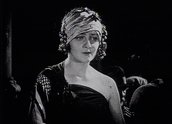
Those Who Love (1926)
Synopsis
Sir James Manton (Robert Purdie), a wealthy society figure, bribes Bébé Dorée (Sylvia Newland), a female dancer, to vanish from the life of his son Barry (William Carter). Abandoning his parents and their money, Barry becomes a wharf labourer and in a cabaret one night meets another dancer, Lola Quayle (Isabel McDonagh billed as 'Marie Lorraine’). The cabaret boss (‘Big’ Bill Wilson) tries to make a pass at Lola, causing Barry to attack him and Lola to lose her job. Barry offers Lola a room, and the two soon marry. When Sir James pleads for Barry to return to his former life, Lola runs away to avoid the risk of Barry losing his inheritance. Embittered by the separation, Barry again rejects his parents’ money and status.
Years later Lola is working as a hospital nurse when Barry is admitted following a wharf accident. Lola tries approaching Barry’s parents to ask them to pay for Barry’s specialist treatment, but Sir James refuses to see her. Sir James’ attitude softens when he meets and is charmed by Peter (Jackie Williamson), the child Lola has had by Barry. The family are reunited after Sir James and his wife (Kate Trefle) recognise the strength of the love between Barry and Lola.
Curator’s notes
In the mid-1920s Those Who Love was a new departure for Australian cinema. At a time when many Australians identified Australian films with bush comedies, Those Who Love was an urban drama skilfully influenced by contemporary Hollywood visual and dramatic conventions. Its producers, Isabel, Phyllis and Paulette McDonagh – promoted as the only team of women filmmakers in the world – were talented, young, publicity-savvy and charmingly persuasive. As daughters of a doctor from the cream of Sydney society, the sisters had social influence besides the ability to make films at a time when most other young women opted for marriage, child-rearing or at least a measure of financial dependence on men.
In the lead-up to making Those Who Love, Paulette McDonagh attended a film acting school run by PJ Ramster, who from 1921 to 1928 under his own auspices directed six features and several short films. Jack Fletcher, who had trained at Paramount studios in Hollywood in the early 1920s, was a cameraman on Ramster’s films, and the McDonaghs employed Ramster and Fletcher to work with them on Those Who Love and The Far Paradise (1928). Ramster was by the mid-1920s a well-known filmmaker, and to take advantage of this recognition the McDonaghs credited him as the director of Those Who Love. Nevertheless, only days into production Paulette took over direction after disagreeing with Ramster’s departures from her script. On 15 July 1928, Sydney’s Sunday Times reported that on Those Who Love and The Far Paradise Ramster had been ’a technical director for the continuity, and under the personal supervision of Paulette McDonagh’.
When the shooting of Those Who Love began at Drummoyne House in Wrights Road in the Sydney suburb of Drummoyne, the film’s electrical carbon arc lighting at first blacked out the entire street. Cast and crew were disabled for several days by ‘klieg eyes’, a form of conjunctivitis brought on by the lighting’s intensity. Cameraman Jack Fletcher developed severe influenza, requiring Phyllis and Paulette to physically hold him up to operate the camera. Seasoned stage actors initially delivered over-the-top performances, a problem Paulette McDonagh solved by showing them their first day’s rushes.
In addition to Jack Fletcher’s camerawork, the opulent look of the McDonaghs’ first two films were the result of the settings, furniture and artworks they were able to film at the McDonagh family mansion Drummoyne House, and of Phyllis McDonagh’s ability to persuade business people to allow their new furniture, clothing, cars, jewellery, shops, offices and hotels to appear on screen in return for free newspaper publicity.
Filmed in ten days at Drummoyne House, the Australasian Films studio at Bondi Junction and other locations around Sydney, Those Who Love was highly publicised during production and on release. ‘Governor Cries at Film’ ran one headline reporting the reaction to the film by the NSW Governor, Sir Dudley de Chair, whose daughter was among the cast. Isabel and Paulette helped promote Those Who Love via a personal appearance tour through the Hoyts circuit, with Isabel introducing the film before screenings.
Critics accustomed to complaining about the shortcomings of Australian films were unanimous in their praise. The Cairns Post (30 March 1928) called it ’a dazzling triumph, and by far the best Australian film that has ever graced the screen’. The Adelaide Register declared it ’a triumph for the Australian industry, both in the light of quality of photographic work and in the general production of the story’. The Melbourne Argus wrote incredulously:
The picture is so well produced that it seems almost inconceivable that it should be the work of three young girls. It speaks much for their enterprise, and further pictures by them will be welcomed.
Those Who Love is now a substantially lost film. Only fragments survive from a film originally running 6000 feet (approximately 66 minutes). Out of its surviving three minutes, the highlight is a waterfront scene between the film’s central lovers, Lola and Barry. Taking place during Lola’s lunchtime visit to Barry’s workplace, it perfectly balances performance realism, light-hearted romance and comic relief, leading the viewer to sincerely regret the loss of the complete film. The remaining fragments are of a party scene filmed on Tamarama Beach, and two moments in a cabaret – Lola’s first sighting of Barry, and a fight between Barry and the cabaret boss.
In later years Paulette and Phyllis McDonagh recalled that Those Who Love had earned more money in Australia than Charles Chaplin’s The Gold Rush (1925). The film netted the McDonaghs £4,000, a quadrupling of their investment.
- Overview
- Curator’s notes
- Video 1 clip
- Principal credits
- Find a copy
- Make a comment
- Map
- Add your review



